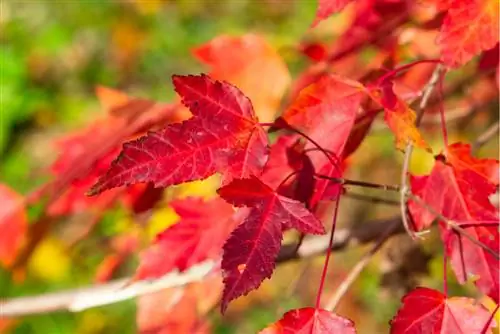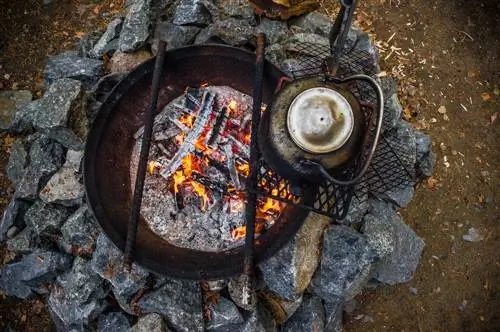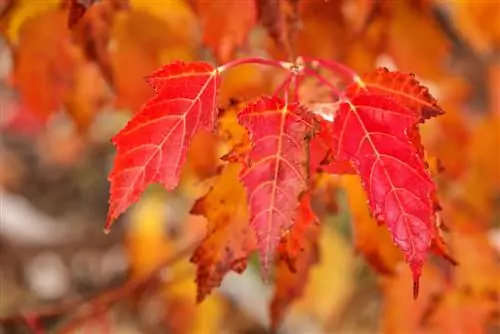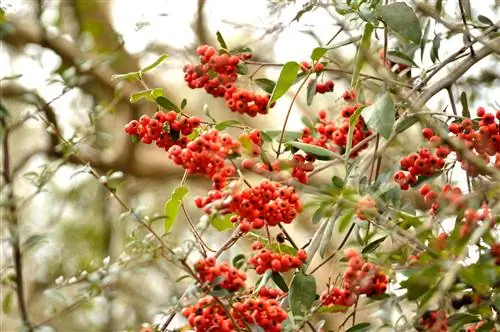- Author admin [email protected].
- Public 2024-01-15 08:07.
- Last modified 2025-06-01 06:02.
Read a commented fire maple profile here with information about growth, leaves, flowers and use. Lots of planting and care tips for hobby gardeners. How to cut Acer ginnala correctly.
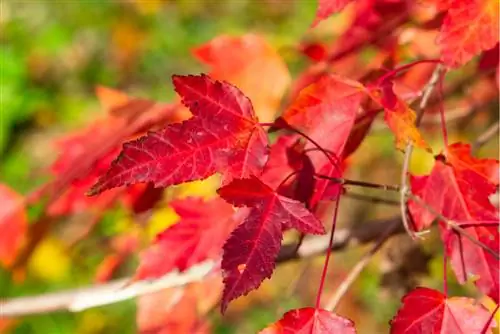
What characterizes the fire maple and what conditions does it need?
The fire maple (Acer ginnala) is an undemanding, deciduous deciduous tree with an impressive fire-red autumn color. It reaches a height of 500 to 600 cm and prefers sunny to partially shaded locations in fresh to moderately dry, humus-rich garden soil.
Profile
- Scientific name: Acer tataricum subsp. ginnala
- Subspecies of the species: Tatar steppe maple (Acer tataricum)
- Family: Sapindaceae
- Origin: China, Manchuria, Japan
- Growth type: deciduous tree
- Growth habit: large shrub, small tree
- Growth height: 500 cm to 600 cm
- Growth width: 300 cm to 700 cm
- Leaf: three-lobed
- Flower: Umbrella Grape
- Fruit: winged
- Use: Single position, hedge plant
Growth
Fire maple is the most important subspecies of the Tatar steppe maple (Acer tataricum) within the section Ginnala from the genus maples (Acer). The decorative deciduous tree is native to China, Japan and Manchuria. For creative hobby gardeners, the habitus, which is worth seeing, is more interesting than the intricate plant system. Why Acer tataricum subsp. ginnala keeps what its German name promises, these key growth data explain:
- Growth type: deciduous tree as a multi-stemmed large shrub or small standard tree.
- Growth habit: loose-upright, wide-spreading, shoots slightly overhanging at the sides, with an umbrella-shaped crown when old.
- Growth height: 500 cm to 600 cm.
- Growth width: 300 cm to 700 cm.
- Bark: light brown, later gray, thin branches on the sunny side with reddish-brown bark.
- Growth rate: 35 cm to 40 cm annual growth.
- Roots: Shallow roots
- Gardenically interesting properties: fire-red autumn color, robust, undemanding, tolerates cutting, heat-tolerant, hardy down to -35° Celsius.
Video: Fire maple with autumnal splendor
Leaf
Fire maple is colorful with its beautifully shaped foliage. You can read all the important leaf characteristics here:
- Leaf shape: petiolate, broadly elliptical, three-lobed (1 large central lobe, 2 smaller side lobes).
- Leaf size: 6 cm to 10 cm long, 4 cm to 6 cm wide.
- Arrangement: opposite
- Colors: Shoots light yellow, later shiny dark green above, light green below.
- Autumn color: intense orange-red from September, bright fire red to dark red in October.
Bloom
In May, fire maple exudes a pleasant scent because it is flowering time. The flowers can be recognized by these characteristics:
- Flower shape: umbrella-shaped, 2 cm to 6 cm long inflorescence with up to 50 individual flowers.
- Single flower: five-fold, disc-shaped, 5 ovoid sepals, 5 elongated, whitish-green petals, 8 stamens.
- Flower ecology: polygamous gender distribution with unisexual and hermaphrodite flowers.
Fruit
From August, Acer ginnala bears interesting fruits with these characteristics:
- Fruit shape: yellowish-green split fruit with two reddish wings.
- Size: 2.5cm to 3.5cm long.
- Fruit ripeness: September and October, recognizable by brown wings.
With small, flat seeds in their luggage, fire maple fruits sail through the air like mini helicopters in autumn. After landing on the forest and garden floor, the ripe fruits split and release the cold-germinating seeds.
Usage
In isolation, as a group or as a hedge, the fire maple stands out impressively. The East Asian tree not only impresses with its representative appearance, but also fulfills important functions in natural garden design. The following table provides an insight into practical and decorative uses:
| Shrub | High trunk | Garden Style |
|---|---|---|
| Privacy hedge | House tree | Japanese Garden |
| Windbreak | Solitaire in the front garden | Natural Garden |
| Slope fastening | Group planting in the park | Forest Garden |
| Ornamental trees | Garden Bonsai | Roof garden |
Planting fire maple
You can buy fire maple ready to plant at the nursery at any time of the year. The quality determines the best planting time. Location preferences are easy to meet. If planted correctly, the tree takes root quickly. When, where and how to skillfully plant Acer ginnala, read here:
Planting time
Saving hunters buy fire maple as a bare-root shrub and in return accept a fixed time window for planting. Potted or baled goods cost higher prices and allow more flexibility when choosing dates. Informative details about planting time in brief:
- Rule of thumb: Ideally plant fire maple during the leafless season.
- Planting time for bare root products: from October to March/April.
- Planting time for potted and baled goods: all year round, as long as the spade goes into the ground.
Location
Plant fire maple in a location with these basic conditions:
- Sun to partial shade (no or minimal autumn color in the shade).
- Normal garden soil, ideally humus-rich, fresh to moderately dry, well-drained and nutrient-rich.
- Exclusion criteria: waterlogged, calcareous, sandy-dry.
As a high trunk, a wind-protected location is recommended because the canopy can sometimes break apart in strong winds.
Planting - Tips & Tricks
Good soil preparation reduces the risk of failure during the delicate growth phase. To ensure that fire maple as a shrub has dense branches at the base, we recommend planting pruning. Planted as a standard tree, the tree is susceptible to windthrow. A look at these planting tips sets the course for a fire maple in top form:
- The planting pit is twice as big as the ball (spread out root crops find enough space in the planting hole).
- A 10 cm high layer of gravel on the bottom of the pit prevents waterlogging.
- Near paved areas, the planting hole is lined with a rhizome barrier.
- The excavation is mixed with 30% sand and compost.
- A watering rim is formed from the excess soil.
- Important: Do not plant fire maple deeper than before in the nursery.
- Drive a support post into the ground next to the standard trunk and connect it to the fire maple trunk.
So that a fire maple bush grows densely bushy, cut back all shoots by a third. The correct interface is always above a bud or a sleeping eye.
Excursus
Fire maple and rock pear - dream team in the autumn garden
A combination of fire maple and copper rock pear (Amelanchier lamarckii) creates picturesque accents with an Indian summer effect. Both trees grow as large, multi-stemmed, broad-spreading shrubs and delight with their bright orange-red to flaming red autumn colors. In spring, the rock pear impresses with lush white flower clusters. At the end of the season, the foliage beauties compete for the most beautiful fruit display. Fire maple boasts red winged split fruits. The copper rock pear boasts blue-black, edible berries.
Care for fire maple
Fire maple is undemanding and easy to care for. The water supply is simple. Acer ginnala is fertilized very sparingly. In contrast to other Asian maple species, pruning care is not a headache. As a subspecies of the Tatar steppe maple, fire maple responds well to generative propagation. The best care tips to read:
Pouring
- Water freshly planted fire maple every 2 to 3 days.
- Water mature, older fire maple thoroughly when it is dry.
- Preferably use collected rainwater as irrigation water.
Fertilize
- Fertilize fire maple once a year in March/April.
- Sprinkle 3 liters of compost on the root disk and pour in.
- Caution: Adding nitrogen-rich blue fertilizer torpedoes the bright autumn colors.
Cutting
Fire maple also tolerates pruning into old wood. This fact significantly simplifies pruning care. The following short instructions explain how to cut the tree correctly:
- The best time is in late winter, ideally between the end of January and the end of February.
- Thin out the bush or treetop.
- Cut off dead, rubbing and inwardly growing shoots at the base without stubs.
- Cut back branches that are out of shape and are in an unfavorable position.
- Pruning: Place the scissors a few millimeters above a bud.
Only a bush flooded with light has a dense coat of leaves. With a rejuvenation cut every three to five years, you can effectively prevent aging and baldness. Remove three to four of the oldest shoots from the tree that have noticeably little foliage and shade young branches.
Propagate
Traditionally, fire maple is propagated by sowing. The cold germs receive the necessary cold stimulus in the open field. This is how you grow a whole flock of young trees:
- Collect winged fire maple fruits in autumn with now brown wings.
- Pull a split fruit apart by the wings to remove the seeds.
- Sow seeds directly in the outdoor bed (dark germinator) and water with a fine spray.
The damp winter cold, ideally in conjunction with a layer of snow, overcomes the inhibition of germination. The first seedlings sprout from March and remain in the seedbed until autumn. Water the seedlings in dry conditions. The young trees are not fertilized.
Popular varieties
In nurseries and garden centers only this variety is mentioned in the same breath as the magnificent fire maple:
Japanese fire maple: Acer japonicum 'Aconitifolium' impresses as a large, broad-bushy shrub with purple flowers and red autumn color, growth height and width of up to 500 cm.
FAQ
My Acer ginnala is multi-stemmed, 6 m high and only has leaves in the crown. Does pruning help?
Acer ginnala is a tree that tolerates pruning very well. From October onwards, your balding fire maple can even tolerate rejuvenation pruning and can be cut back to a third of its height. In response to the vigorous pruning, the shrub sprouts again with a dense coat of foliage from the base to the crown. We also recommend an organic nutrient supply, for example with compost and horn shavings.
Should fire maple be pruned after planting as a hedge plant to ensure dense branching?
Pruning is definitely recommended. On the day of planting, cut back all shoots by at least 10 to 15 percent. Place the scissors just above an outward-facing bud. In this way you create a sap build-up in the shoot, which activates increased budding. The result is dense branching over the entire height, as you would expect from an opaque hedge plant.
At what distance from the fencing hedge should a fire maple be planted?
Fire maple is a strong-growing, sprawling, wide shrub that can grow up to 7 m wide. A planting distance of 3.50 m to 4 m from the neighboring hedge ensures that you can carry out maintenance work comfortably. Furthermore, the large shrub will not affect the growth of the hedge by casting shadows in later years.
Can you transplant an older fire maple tree? What should you pay attention to?
In the first five years of standing, the fire maple survives a change of location well. The best time is during the leafless season, ideally in autumn or spring. Cut the root ball at least to the diameter of the crown. Do not shake off the previous soil. In the new location, plant the shrub just as deep in the ground as before. The lost root mass is compensated for by pruning.

